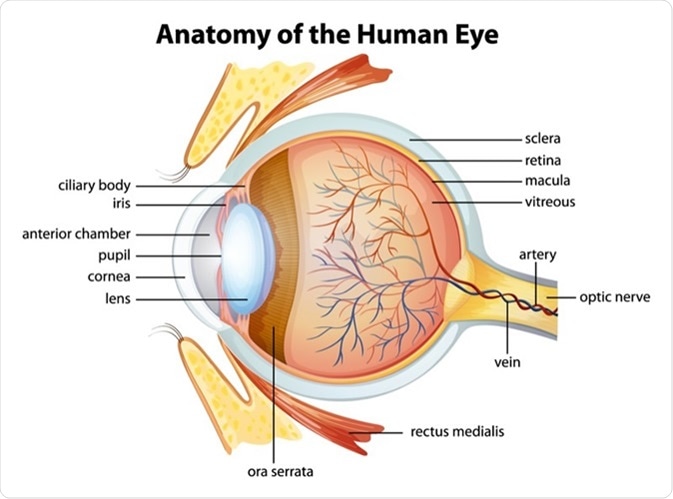Iridodonesis is a condition in which the iris (coloured part of the eye) vibrates during eye movements. Upon moving the eye rapidly, the iris can appear to ‘dance’, or ‘tremble’ (tremulousness). This occurs when the lens becomes partially detached (lens subluxation) from its suspensory ligaments. This itself is often asymptomatic and only becomes apparent upon physical examination of the eye.
What causes iridodonesis?
The primary cause of iridodonesis is the subluxation of the lens. This may occur as a result of glaucoma, cataract formation, post-surgical complications, or trauma to the eye. The subluxation of the lens rarely occurs naturally; however, there are reported cases of iridodonesis occurring due to genetic mutations that affect the strength of connective tissues.
In one case report, a 65-year old woman who was being evaluated for Marfan’s syndrome, a genetic disorder which affects the connective tissues of the body, also had iridodonesis. It was found that the patient had a mutation in the FBN1 gene, which encodes fibrillin, a major component of elastic fibers that are part of the body’s connective tissue.
Patients with Marfan’s syndrome tend to have abnormally loose elastic tissue. Within the eye, this appears as lax ciliary zonules.
Basic anatomy of the ciliary body
The ciliary body is a structure composed of two parts: a ring of circular muscle that is an extension of the iris, and the ciliary epithelium that produces the aqueous humor in the anterior chamber of the eye. The ciliary muscle inserts into the ciliary zonules, and contracts or relaxes to produce a thinner or thicker lens, with lower or higher refractive power respectively.

The ciliary zonule or the zonule of Zinn is a ring or band of fibers 1-2 microns wide, attaching the ciliary body to the lens. It has two layers: a thin layer, which lines the hyaloid fossa, and a thicker layer comprising the zonular fibers. They compose the suspensory ligament of the lens. When these fibers loosen, it leads to the partial dislocation of the lens (called ectopia lentis), resulting in iridodonesis.
The weakened ciliary zonules in Marfan’s syndrome thus lead to lens subluxation. Therefore, iridodonesis is a hallmark of Marfan’s syndrome.
Another case report recorded periodic episodes of vertigo due to the tremulousness of the iris with eye movement. These episodes may be little more than a second long. In this particular case, the researchers concluded that the tremulousness of the iris caused a trembling of the retina, leading to irritation of associated neural pathways.
However, in most cases of iridodonesis, the vibration of the lens does not result in any symptoms.
How is iridodonesis managed?
Since iridodonesis is a direct consequence of lens subluxation, treating the cause of the detachment by surgical approaches may help reduce the tremulousness of the iris. However, in patients with a genetic cause for iridodonesis, there is often no cure. As iridodonesis usually does not result in any apparent symptoms, apart from the rare case of vertigo, it can often be left alone unless complications arise.
Sources
- Desai & Tajik, 2017. N Engl J Med. 377:e14 www.nejm.org/…/NEJMicm1615424
- Kunte et al, 2015. Neurology 85(15) https://n.neurology.org/content/85/15/1353
Further Reading
- All Iridodonesis Content
Last Updated: Mar 27, 2019

Written by
Osman Shabir
Osman is a Neuroscience PhD Research Student at the University of Sheffield studying the impact of cardiovascular disease and Alzheimer's disease on neurovascular coupling using pre-clinical models and neuroimaging techniques.
Source: Read Full Article
